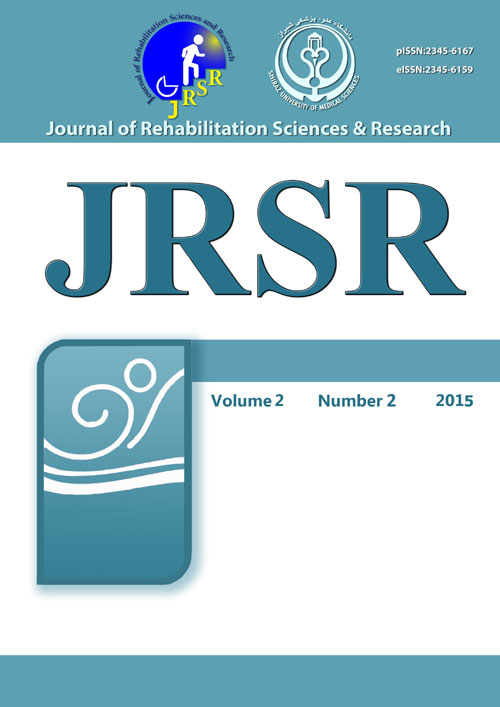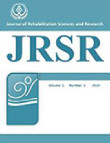فهرست مطالب

Journal of Rehabilitation Sciences and Research
Volume:2 Issue: 2, Jun 2015
- تاریخ انتشار: 1394/06/30
- تعداد عناوین: 5
-
Pages 23-26BackgroundForward head posture (FHP) is recognized as a common postural disorder of modern societies. Increase in anterior cervical convexity and anterior displacement of the line of gravity of head in individuals with FHP is assumed to result in altered moment arms and muscle activity on cervical spine. Measurement of muscle thickness seems to be an appropriate index for muscle activity. This study was aimed to compare cervical extensor muscle thickness in individuals with normal head posture with those suffering from FHP.MethodsTwenty volunteers with FHP and 20 matched controls (11 females and 9 males in each group) participated in this cross-sectional study. The thickness of cervical extensor muscles including multifidus, semispinalis cervicis, semispinalis capitis, splenius capitis and upper trapezius were measured using ultrasonography at the level of forth cervical vertebrae at rest.ResultsNo significant differences of thickness of cervical extensor muscles were observed between the two groups (p<0.05) at of rest.ConclusionThe results of this study showed that the thickness of cervical extensor muscles at the level of forth cervical vertebrae in individuals with FHP did not change in comparison with normal head posture at rest. Further studies are recommended to evaluate extensor muscles at other levels of cervical spine.Keywords: Cervical spine, Extensor muscles, Forward head posture, Ultrasonography, thickness
-
Pages 27-30BackgroundThe aim of the present study was to assess the auditory working memory span of children with (central) auditory processing disorders (C) APD aged 8 to 10 years and to compare the results with normal ones.MethodsTwenty five children with (Central) Auditory Processing Disorders (8-10 years) and 75 normal children (8-10 years) from both genders participated in this comparative study. Participants were chosen by convenient sampling method to assess their auditory working memory (WM) span. Forward digit span, backward digit span and non-word repetition tests were used to evaluate the WM span. Nonparametric statistics (Mann–Whitney U) were used for comparing group differences.ResultsForward digit and backward digit and non-word repetition tests showed significant differences in mean scores between those with (C) APD and normal children (p˂0.001).ConclusionThe results suggest that (C) APD children have poorer performance in the WM span than the age matched controls.Keywords: Working memory span, Central auditory processing disorder, Top, down function
-
Pages 31-36BackgroundClassroom behaviors are disturbed in autistic students because of their repetitive, restlessness, and disruptive behaviors. This study aimed to examine the impacts of sitting on a ball, cushion, and/or common chair on classroom behavior of four students with Autism Spectrum Disorder (ASD).MethodsFour children with Autism participated in this single-subject study. Students’ behaviors were video recorded in three phases: Sitting on their common chairs during phase A, air-sit cushioned in phase B, and ball chairs in phase C. Sitting times and on-task/off-task behaviors were quantified by momentary time sampling (every 10 seconds) and compared during different phases for important changes. Social validity was taken by the teacher at the end of the research as well.ResultsThe findings demonstrated increases in on-task and in-seat behaviors in four students when seated on air sit cushioned chairs. Despite rises of on-task behaviors for all students, only two of the students showed enhanced in-seat behaviors when seated on therapy balls. Social validity findings indicated that the teacher preferred the use of the balls and air-cushioned chairs for her students.ConclusionTherapy balls/cushioned chairs for students with ASD may facilitate in-seat and on-task behavior.Keywords: Autism spectrum disorders, Students, Sensory integration
-
Pages 37-40BackgroundLow back pain (LBP) is one of the most common musculoskeletal complications of today’s societies which, poses a big portion of health expenses and work absentees. Lumbar disc herniation is claimed to be one of the several causes of LBP. Conservative therapies like physiotherapy are found to be beneficial for treatment in such a kind of LBP. However, there is low evidence proving traction therapy can be effective. Therefore, the aim of this study was to evaluate effects of a 7-day physiotherapy protocol along with segmental traction therapy on pain and range of motion in patients with acute LBPMethodsA total of 9 patients with acute LBP voluntarily participated in this study. They undertook a 7-day conventional physiotherapy along with segmental traction therapy. Pain, functional ability and lumbar flexion range of motion (ROM) were measured before and after the therapeutic intervention.ResultsA significant reduction in pain was observed after the intervention (p=0.006). In addition, patients’ functional ability increased significantly (p=0.03).However, there were no significant changes in lumbar in flexion ROM.ConclusionAccording to results of the present study segmental traction therapy along with a physiotherapy protocol consisting of TENS, Ultrasound and Hot pack reduces pain and improves functional ability in patient with acute LBP. Although no effect on lumbar ROM is expected.Keywords: Acute Low Back Pain, Physical Therapy, Traction
-
Pages 41-46BackgroundCentre of pressure displacement is an indicator of postural control. Children with cerebral palsy have poor postural control. One common intervention to enhance their balance is vestibular stimulation. The aim of this research was to investigate the effect of vestibular stimulation on COP parameters in children with cerebral palsy (3-10 years old).MethodsThis study was a randomized double-blind controlled clinical trial. Twenty children with cerebral palsy received vestibular stimulation, two sessions per week with a course of twelve sessions, based on vestibular stimulation protocol including anteroposterior, lateral, ascending – descending movements and spinning. One cerebral palsy group experienced current and conventional occupational therapy while the other received a period of vestibular stimulation during treatment. Force plate outcome measures were center of pressure displacement parameters as well as velocity, area, displacement in X and Y axes.ResultsAccording to Mann-Whitney U test, means in post-tests in two groups with both conditions of eyes open and closed were significant in velocity parameter (eyes open P= 0.036; eyes closed P = 0.021) while Area parameter, COP displacement in X axis (Rang fore after), COP displacement in Y axis (Rang side way) were not significant (P>0.05). Wilcoxon Test showed significant difference in the velocity parameter; eyes open (P=0.012) and eyes closed (P =0.018).ConclusionChildren who received vestibular stimulation are able to change and control COP displacement faster (according to changes in velocity parameters). So we suggest rehabilitation team members especially occupational therapist to apply vestibular stimulation during their treatment.Keywords: Occupational therapy, Cerebral palsy, Vestibular stimulation, Balance, children Development, Force plate


